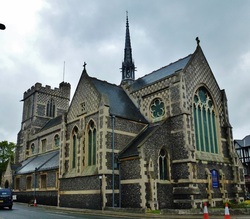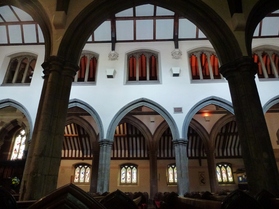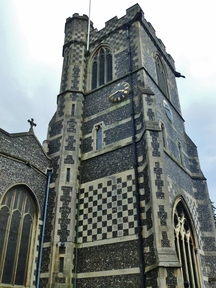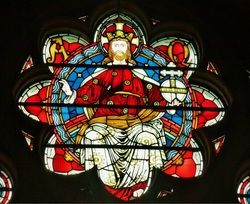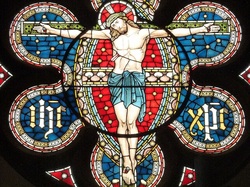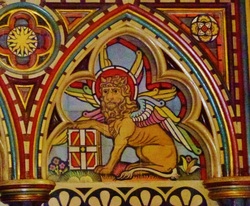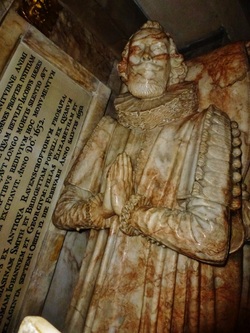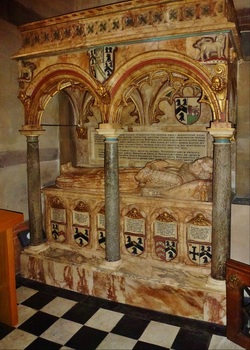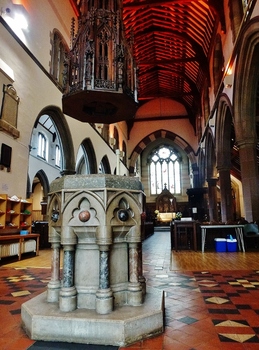St. John the Baptist, Chipping Barnet.
Barnet fair bogof[15].
At the top of the High Street after the long hill from London, the church separates the roads going west to Watford and north to Newcastle with its chequerwork choir. Once a Hertfordshire peninsular pointing into Middlesex, Barnet is now the last of London reaching out of town. The Chipping in Barnet referred to the fair, the slang of the Cockneys rhymed it with hair. The church here is a daughter of that at East Barnet, but the importance of its position on the Great North Road and of the fair led to this chapel of ease becoming the greater building, even before Butterfield more than doubled its size. In the first half of the fifteenth century, the church was rebuilt with money from local tradesmen, who had formed themselves into a guild. John Beauchamp, a maltster, has a plaque of 1453 in the church naming him as a major donor and requesting prayers for his soul, though during the Reformation this part was deleted. Speculation based on mouldings suggests a link with the work of Thomas Wolvey, and the mason may have been his son John. The two elegant arcades of the nave remain with the north aisle and both clerestories above, angel corbels holding shields below the roof.
Barnet fair bogof[15].
At the top of the High Street after the long hill from London, the church separates the roads going west to Watford and north to Newcastle with its chequerwork choir. Once a Hertfordshire peninsular pointing into Middlesex, Barnet is now the last of London reaching out of town. The Chipping in Barnet referred to the fair, the slang of the Cockneys rhymed it with hair. The church here is a daughter of that at East Barnet, but the importance of its position on the Great North Road and of the fair led to this chapel of ease becoming the greater building, even before Butterfield more than doubled its size. In the first half of the fifteenth century, the church was rebuilt with money from local tradesmen, who had formed themselves into a guild. John Beauchamp, a maltster, has a plaque of 1453 in the church naming him as a major donor and requesting prayers for his soul, though during the Reformation this part was deleted. Speculation based on mouldings suggests a link with the work of Thomas Wolvey, and the mason may have been his son John. The two elegant arcades of the nave remain with the north aisle and both clerestories above, angel corbels holding shields below the roof.
To the south this original clerestory looks into a much higher new nave, as in 1871 William Butterfield removed the chancel, south aisle and most of the west tower. He replaced these with the higher nave, with its own aisle and chancel, putting an organ chamber and vestries in place of the original east end, and added a massive west tower in line with his new work, all of which was finished externally with much flint and stone chequer; a bit like a Hertfordshire steeple on steroids. His window tracery and detailing were Geometric in the Butterfield manner, and inside he employed his favourite banding with coloured stone. All of his stylistic quirks are here, though moderately employed, building up from his red and grey font with its marble columns and roundels to his trademark tiled reredos. The original font went for a birdbath, though he re-used a vestry doorway and door, hiding them away inside the organ chamber, and kept the miniature vaulted canopies of two niches, now beside the west door. In one three heads act as bosses, the central one pulling open his mouth with two tiny arms. The glass in the chancel has strong designs of 1880 by Heaton, Butler and Bayne, with angels in rose windows up by the roof, and a big Ascension behind his tiled east wall, which shows the symbols of the Evangelists and a central Nativity on the gabled reredos. Splendid lions stick out their tongues on tiles against a background of reds, greys, yellows and washed out purples. Above the organ is a spectacular crucifixion roundel, also by Heaton, Butler and Bayne; more angels by Westlake fill his southern nave clerestory windows and saints by Holiday his south aisle.
At the east end of this aisle he formed a transept, though it has little purpose except as an ante room to the tiny eastern chapel he formed to take the ornate canopied tomb of the recusant[16] Thomas Ravenscroft, J.P. , M.P. and clerk in Chancery who died in 1630. This tomb is a mixture of gothic and classical with much heraldic detail, perhaps showing him to have been traditionalist in more than his religion. It may have round arches on Ionic columns, but they are decorated with delicate openwork cusping; lions on caps of maintenance are carved over gilded putti, and a quatrefoil frieze runs along the top of the vaulted canopy. Amongst this splendour his bearded effigy lies, carved of veined alabaster, wearing a ruff and judges’ robes with frogging up the sleeves. The coats of arms of his two wives are shown behind him, and those of his children along the chest tomb below. He was a younger son from Hawarden near Chester, who managed to make enough money for his own son to set up a trust that still pays for the upkeep of the tomb, the chancel, and 60 almshouses. This son James invented Ravenscroft glass, making the silica from flint; his bust is copied in a memorial in the transept. The pulpit and pews, the stalls and font canopy are all to the designs of J.C. Traylen, each pew end showing a different scene. All of this woodwork was made by the Exeter firm of Harry Hems, responsible for masses of carving in every corner of the Empire. Like most of his work, it’s highly skilful but somewhat dull; the design never really catches fire or excites. Proficiency is rarely enough if you want art as well as craft. Traylen was responsible for the roof top fleche, added in the 1890s to imaginatively solve a problem of ventilation; this seems to draw the disparate parts of these two buildings together, making it a little less of a cut-and-shut[17] church.
This town church makes a point of being open daily, and is in the centre of town.
[15]“ Buy one, get one free” , market acronym
[16] Recusants were secret Roman Catholics, holding onto their beliefs in Protestant England in the face of draconian laws.
[17] Local term for a single motor made out of two damaged cars.
[16] Recusants were secret Roman Catholics, holding onto their beliefs in Protestant England in the face of draconian laws.
[17] Local term for a single motor made out of two damaged cars.
All rights reserved for this entire site. Copyright reserved to stiffleaf for all text and images, which may not be reproduced without my permission.
